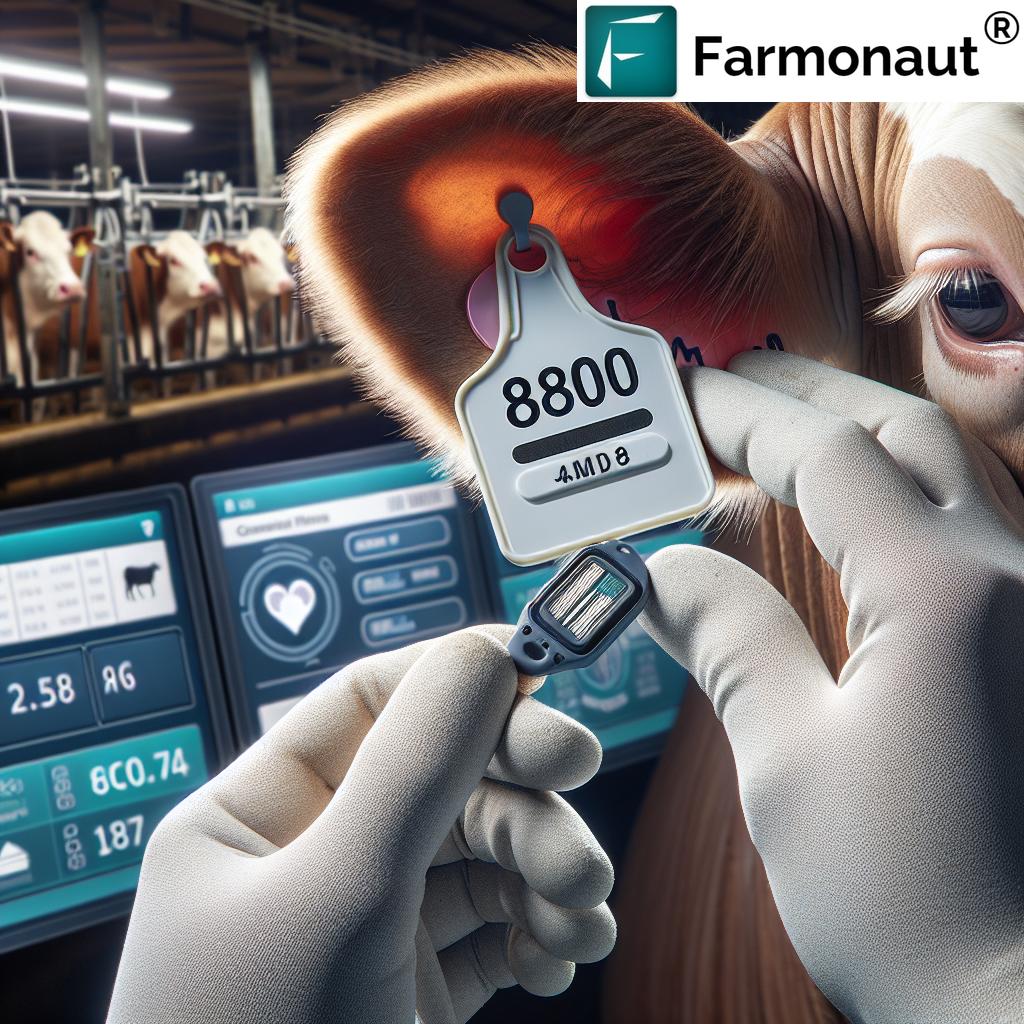Revolutionizing Nebraska’s Livestock Management: How EID Tags Are Transforming Animal Health and Farm Efficiency
“USDA-approved 840 EID tags will replace traditional metal bangs tags for heifers starting November 5, revolutionizing livestock management.”

In the heart of the Midwest, a technological revolution is sweeping across the prairies of Nebraska, transforming the way we manage our livestock and enhance animal health. As we step into a new era of precision agriculture for livestock, electronic identification (EID) tags are at the forefront of this agricultural technology innovation. These smart farming solutions are not just changing the game for our state’s ranchers and farmers; they’re setting a new standard for the entire livestock industry across the democratic republic of the United States.
We’re witnessing a significant shift in animal identification methods, moving from traditional metal bangs tags to USDA-approved EID tags. This transition marks a milestone in our journey towards more efficient and effective livestock tracking systems. As we delve into the impact of this change, we’ll explore how these new tags are revolutionizing everything from veterinary health inspection tools to the very way we approach animal health management technology.
The Dawn of a New Era in Livestock Identification
Starting November 5, a new chapter begins in the annals of Nebraska’s agricultural history. The United States Department of Agriculture (USDA) has mandated a shift from the time-honored metal bangs tags to the more sophisticated 840 EID tags for heifers receiving brucellosis vaccines. This move, orchestrated by the Animal and Plant Health Inspection Service, is not just a change in tagging methods—it’s a leap towards enhancing our capability to track and respond to diseases in our livestock population.
- Enhanced disease tracking and response
- Streamlined animal movement monitoring
- Improved efficiency in veterinary health inspections
These EID tags represent more than just a technological upgrade; they embody our commitment to the health and welfare of our animals and the sustainability of our agricultural practices. As we embrace this change, we’re not just adapting to new regulations—we’re actively participating in the modernization of farm management practices.
Understanding EID Tags: The New Frontier in Animal Identification
Electronic identification tags for livestock are more than just a modern version of their metal predecessors. These small devices pack a powerful punch when it comes to managing our herds efficiently. Each EID tag comes with a unique identification number that can be read both visually and electronically, offering a level of versatility that was previously unattainable.
“Each EID tag provides a unique identification number readable both visually and electronically, enhancing disease tracking and response.”
The beauty of these tags lies in their dual functionality:
- Visual Identification: Like traditional tags, EID tags can be read by the human eye, allowing for quick checks during routine farm operations.
- Electronic Reading: The real game-changer is the ability to scan these tags electronically, enabling rapid data collection and processing.
This dual-read capability opens up a world of possibilities for livestock management, from streamlining auctions to enhancing the efficiency of veterinary visits. It’s a step towards a more connected and data-driven agricultural sector, aligning perfectly with the principles of precision agriculture that we’re increasingly adopting across our farms and ranches.
The Impact on Nebraska’s Agricultural Landscape
As we implement these new EID tags across our state, we’re not just changing a small aspect of livestock management—we’re fundamentally altering the agricultural landscape of Nebraska. Our corn fields and hay meadows may look the same, but the way we manage the animals that graze them is undergoing a significant transformation.
- Improved tracking of animal movement across state lines
- Enhanced ability to respond quickly to disease outbreaks
- More efficient management of livestock at auctions and sales
For our producers, whether they’re tending to cattle on the vast prairies or managing smaller herds on family farms, this change brings both challenges and opportunities. The initial adjustment to new tagging requirements and placement techniques may require some adaptation, but the long-term benefits for animal health and farm efficiency are substantial.

Transitioning from Metal to EID: What Producers Need to Know
The shift from traditional metal tags to EID tags is more than just a change in equipment—it’s a shift in mindset and practice. Here’s what our Nebraska producers need to be aware of as they navigate this transition:
- Phasing Out: While existing metal tags remain valid, they will be gradually phased out. It’s crucial to start incorporating EID tags into your livestock management strategy.
- New Tagging Techniques: EID tags may require different placement methods compared to traditional tags. Training and practice will be essential for proper application.
- Equipment Upgrades: Farms and ranches may need to invest in electronic readers and update their data management systems to fully leverage the benefits of EID tags.
To ease this transition, the USDA is providing initial tags to producers. This support underscores the importance of this change and the government’s commitment to helping our agricultural community adapt to new technologies.
The Role of EID Tags in Disease Prevention and Control
One of the most significant advantages of EID tags is their potential to revolutionize disease prevention and control in livestock. In a state where animal health is paramount to our agricultural economy, this aspect of EID technology cannot be overstated.
- Rapid Traceability: In the event of a disease outbreak, EID tags allow for quick identification and tracking of affected animals.
- Efficient Quarantine Measures: The ability to quickly isolate and manage potentially infected animals can prevent widespread outbreaks.
- Detailed Health Records: Electronic tags facilitate the maintenance of comprehensive health records for each animal, enabling more personalized and effective veterinary care.
By enhancing our ability to monitor and respond to health issues, EID tags are not just a tool for compliance—they’re a critical component in safeguarding the health and welfare of our livestock population.
EID Tags and the Future of Livestock Auctions
The implementation of EID tags is set to transform the landscape of livestock auctions across Nebraska and beyond. These digital animal identification methods are poised to streamline the auction process, making it more efficient and transparent for both buyers and sellers.
- Faster Processing: Electronic scanning of tags can significantly reduce the time needed to process animals at auctions.
- Accurate Record-Keeping: Digital records associated with EID tags provide comprehensive information about each animal’s history.
- Enhanced Buyer Confidence: Access to detailed animal histories can increase buyer confidence, potentially leading to better prices for quality livestock.
As our state’s auction houses adapt to this new technology, we anticipate seeing a more dynamic and efficient marketplace for livestock. This modernization aligns with broader trends in agricultural technology innovations, positioning Nebraska’s livestock industry at the forefront of technological adoption.
The Economic Impact of EID Tag Implementation
While the initial implementation of EID tags represents an investment for our producers, the long-term economic benefits are expected to be substantial. Let’s break down the potential economic impact:
- Increased Efficiency: Streamlined processes can lead to labor cost savings over time.
- Improved Market Access: Enhanced traceability may open up new market opportunities, particularly for exports.
- Reduced Disease Costs: Better disease management can significantly reduce the economic impact of outbreaks.
- Value-Added Opportunities: Detailed animal histories can create premium product lines, potentially commanding higher prices.
While there may be short-term costs associated with transitioning to EID tags, the long-term benefits for Nebraska’s agricultural economy are promising. As we embrace this technology, we’re not just investing in tags—we’re investing in the future of our livestock industry.
EID Tags and Precision Livestock Farming
The adoption of EID tags is a significant step towards precision livestock farming, a concept that’s gaining traction across the agricultural sector. By integrating EID technology with other smart farming solutions, we’re opening the door to a new era of data-driven animal husbandry.
- Individualized Animal Management: EID tags enable personalized tracking of each animal’s health, nutrition, and performance.
- Integration with Farm Management Software: Data from EID tags can be seamlessly incorporated into broader farm management systems.
- Predictive Health Monitoring: By analyzing trends in animal data, farmers can potentially predict and prevent health issues before they become serious.
This move towards precision in livestock management aligns with the broader trends we’re seeing in crop management, where technologies like satellite imagery and AI-driven analytics are becoming increasingly common. As we continue to embrace these innovations, we’re not just improving our farming practices—we’re reimagining what’s possible in agriculture.
Comparing Traditional Metal Tags and EID Tags
To fully appreciate the impact of this transition, it’s helpful to directly compare traditional metal tags with the new EID tags. The following table highlights key differences:
| Aspect | Traditional Metal Tags | EID Tags |
|---|---|---|
| Readability | Visual only | Visual and electronic |
| Unique Identification | Limited | Highly specific |
| Disease Tracking Efficiency | Moderate | High |
| Data Management Ease | Manual, time-consuming | Automated, efficient |
| Animal Movement Monitoring | Basic | Advanced, real-time capable |
| Veterinary Health Inspection Process | Manual checks | Streamlined, data-driven |
| Estimated Implementation Cost | Low | Moderate to High (initial investment) |
| USDA Compliance | Being phased out | Fully compliant |
| Longevity/Durability | Good | Excellent |
| Farm Management Impact | Limited | Significant, transformative |
This comparison clearly illustrates the advantages that EID tags bring to modern livestock management, particularly in areas of data management, disease tracking, and overall farm efficiency.
The Role of Technology Partners in the EID Transition
As Nebraska’s agricultural community embraces this technological shift, the role of technology partners becomes increasingly important. Companies specializing in agricultural technology innovations are playing a crucial role in facilitating this transition. One such company making waves in the precision agriculture sector is Farmonaut.
While Farmonaut’s primary focus is on crop management through satellite-based solutions, their approach to integrating technology into agriculture aligns closely with the principles behind the EID tag transition. Their platform demonstrates how advanced technologies can be applied to enhance agricultural practices, much like how EID tags are revolutionizing livestock management.
- Data-Driven Decision Making: Just as Farmonaut uses satellite data for crop health monitoring, EID tags provide data for informed livestock management decisions.
- Precision Agriculture: The concept of precision agriculture, central to Farmonaut’s mission, is equally applicable to livestock management through EID tags.
- Technology Integration: Farmonaut’s success in integrating various technologies (satellite imagery, AI, blockchain) showcases the potential for integrating EID tag data with other farm management systems.
While Farmonaut itself doesn’t directly deal with livestock management or EID tags, their innovative approach to agricultural technology serves as an inspiring example of how tech can transform farming practices. As we move forward with EID tag implementation, partnerships with tech companies specializing in agricultural solutions will be crucial in maximizing the benefits of this new technology.
For those interested in exploring how technology can enhance farm management practices, you can check out Farmonaut’s offerings:
For developers interested in integrating agricultural data into their own systems, Farmonaut also offers an API. You can find more information in their API Developer Docs.
Preparing for the Future: What’s Next for Nebraska’s Livestock Industry?
As we embrace EID tags and the technological advancements they bring, it’s important to look ahead and consider what this means for the future of Nebraska’s livestock industry. This transition is just the beginning of a larger shift towards a more technologically integrated and data-driven agricultural sector.
- Continued Technological Integration: We can expect to see further integration of EID tag data with other farm management technologies, creating more comprehensive and efficient systems.
- Enhanced Traceability: As consumers become more interested in the origin and journey of their food, EID tags will play a crucial role in providing this transparency.
- Research and Development: The data collected through EID tags will likely fuel new research, potentially leading to improvements in breeding programs, feed efficiency, and disease resistance.
- Policy and Regulation: As this technology becomes more widespread, we may see new policies and regulations emerge to standardize its use and ensure data privacy.
The adoption of EID tags is not just about compliance with USDA regulations—it’s about positioning Nebraska’s livestock industry at the forefront of agricultural innovation. By embracing these changes, we’re setting the stage for a more efficient, sustainable, and prosperous future for our state’s farmers and ranchers.
FAQs: Understanding EID Tags and Their Impact
Q: When do I need to start using EID tags?
A: The transition begins on November 5, with USDA-approved 840 EID tags replacing traditional metal bangs tags for heifers receiving brucellosis vaccines. However, it’s advisable to start incorporating EID tags into your management practices as soon as possible.
Q: Will I need to replace all my existing metal tags immediately?
A: No, existing metal tags remain valid but will be phased out gradually. It’s recommended to start using EID tags for new animals and when replacing old tags.
Q: How much will this transition cost my farm?
A: While there is an initial investment in EID tags and possibly in reading equipment, the USDA is providing initial tags to ease the transition. Long-term benefits in efficiency and management are expected to offset these costs.
Q: How will EID tags affect my day-to-day farm operations?
A: EID tags will streamline many processes, including record-keeping, health management, and movement tracking. While there may be a learning curve, the overall impact on daily operations is expected to be positive, saving time and improving accuracy.
Q: Can EID tags really help prevent disease outbreaks?
A: Yes, EID tags significantly enhance our ability to track animal movements and health histories. This rapid traceability is crucial in quickly identifying and isolating potential disease outbreaks, thereby preventing wider spread.
Conclusion: Embracing the Future of Livestock Management
As we conclude our exploration of how EID tags are revolutionizing Nebraska’s livestock management, it’s clear that we’re standing at the threshold of a new era in agriculture. This transition from traditional metal tags to electronic identification represents more than just a change in tagging methods—it’s a fundamental shift in how we approach animal health, farm efficiency, and the overall management of our livestock industry.
The implementation of EID tags aligns perfectly with the broader trends we’re seeing in precision agriculture and smart farming solutions. By embracing this technology, Nebraska’s farmers and ranchers are not just keeping pace with regulatory changes; they’re positioning themselves at the forefront of agricultural innovation.
As we move forward, the integration of EID tags with other emerging technologies will likely open up new possibilities we have yet to imagine. From enhancing our ability to respond to disease outbreaks to improving the efficiency of livestock auctions, the ripple effects of this change will be felt across every aspect of our agricultural sector.
While the transition may present some challenges, the long-term benefits for animal health, farm productivity, and overall industry sustainability are immense. By working together—farmers, veterinarians, technology providers, and regulatory bodies—we can ensure a smooth transition that sets the stage for a more efficient, transparent, and prosperous future for Nebraska’s livestock industry.
As we embrace these changes, we’re not just adapting to new regulations; we’re actively shaping the future of agriculture in our state and beyond. The journey ahead is exciting, and with EID tags leading the way, Nebraska’s livestock industry is well-positioned to thrive in the digital age of farming.




















